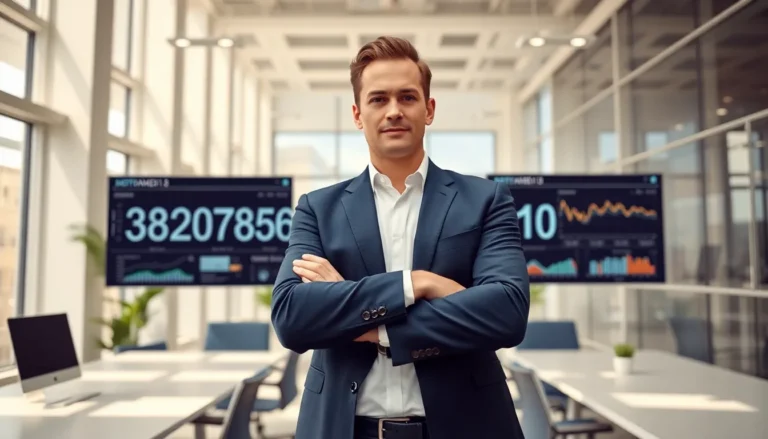In a world where plastic straws are the new villain and eco-friendly is the new black, sustainable design is stepping into the spotlight. It’s not just about saving the planet anymore; it’s about creating spaces that make you feel good while doing good. Imagine living in a home that hugs the environment instead of giving it a bear hug of destruction.
Sustainable design isn’t just a trend; it’s a lifestyle choice that combines creativity with responsibility. Designers are now crafting everything from energy-efficient buildings to biodegradable furniture, proving that going green doesn’t mean sacrificing style. So buckle up and prepare to dive into the world of sustainable design, where innovation meets environmental consciousness and every choice counts. Who knew saving the planet could look this good?
Table of Contents
ToggleWhat Is Sustainable Design?
Sustainable design refers to the practice of creating products and spaces that use resources efficiently while minimizing environmental impact. It integrates eco-friendly materials and energy-efficient technologies into the design process. Designers focus on durability and functionality to reduce waste over time.
This approach prioritizes the health of both people and the planet. For instance, sustainable buildings often feature natural lighting and ventilation, reducing reliance on artificial energy sources. Architects consider the life cycle of materials when planning structures. This consideration includes sourcing, manufacturing, and disposal stages.
Another aspect of sustainable design involves using renewable resources. Designers implement practices that encourage recycling and upcycling, ensuring materials remain in use rather than ending up in landfills. Biodegradable furniture, made from sustainable materials, exemplifies how functionality can align with environmental responsibility.
Water conservation also plays a significant role in sustainable design. Incorporating technologies such as rainwater harvesting or drought-resistant landscaping further supports this goal. Many projects now utilize gray water systems, which recycle water from sinks and showers for irrigation.
Ultimately, sustainable design presents an innovative intersection of aesthetics and eco-conscious principles. Creativity thrives as designers explore ways to blend functionality with green practices. This fusion helps create spaces that are not only visually appealing but also contribute positively to the environment. Sustainable design ensures future generations enjoy a healthier planet and more sustainable living conditions.
Principles of Sustainable Design

Sustainable design integrates various key principles that promote environmental health, social equity, and economic viability. Each principle plays a crucial role in fostering a more conscientious approach to design.
Environmental Considerations
Environmental considerations focus on minimizing ecological impact. Designers prioritize using renewable resources, opting for materials with low environmental footprints, and enhancing energy efficiency. Strategies like passive solar design and the use of non-toxic materials support this aim. Natural lighting and ventilation reduce reliance on artificial energy sources. Rainwater harvesting systems enable efficient water use. Proper site selection further prevents ecosystem disruption, ensuring that natural habitats remain protected.
Social Responsibility
Social responsibility emphasizes the well-being of communities. Designers consider inclusivity by creating spaces that accommodate diverse needs and encourage interaction. Affordable housing solutions emerge as a critical aspect, ensuring that everyone accesses quality living conditions. The wellbeing of occupants takes precedence, leading to designs that foster health through natural elements and open spaces. Education about sustainable living practices also forms part of this principle, empowering communities with essential knowledge about environmental stewardship.
Economic Viability
Economic viability integrates cost-effectiveness with sustainability. Investing in energy-efficient technologies yields long-term savings through reduced utility costs. Designers emphasize life-cycle assessments to evaluate material durability and maintenance needs. This approach leads to informed decisions that support sustainable choices without sacrificing quality. Local sourcing fosters regional economic growth, reducing transportation costs and encouraging community development. Eco-friendly buildings also attract tenants willing to pay a premium for green features, enhancing marketability for developers.
Benefits of Sustainable Design
Sustainable design offers numerous advantages that extend beyond aesthetics and into improved quality of life.
Reduced Environmental Impact
Reducing environmental impact emerges as a primary benefit. Sustainable design prioritizes the use of renewable resources and non-toxic materials, which minimizes adverse effects on ecosystems. Utilizing energy-efficient technologies, designers significantly decrease electricity and water consumption. Passive solar design further contributes by optimizing natural light and ventilation, enhancing energy savings. Incorporating recycled or upcycled materials also cuts down on waste in landfills. Ultimately, adopting sustainable practices fosters healthier environments and supports biodiversity.
Enhanced User Experience
Enhanced user experience sets sustainable design apart. Spaces created with sustainability in mind often prioritize comfort and functionality, contributing to overall well-being. Natural lighting enhances mood and productivity while reducing the need for artificial lighting. Thoughtful design promotes air quality through effective ventilation systems, creating healthier indoor environments. Accessibility features cater to diverse needs, ensuring that everyone can enjoy a space. Designers focusing on user-centric principles foster atmospheres that inspire and connect with inhabitants.
Long-Term Cost Savings
Long-term cost savings present another compelling reason to embrace sustainable design. Initial investments in energy-efficient technologies often lead to reduced utility bills, offering financial relief over time. Durable materials tend to require fewer replacements, minimizing maintenance costs. Sustainable buildings also typically experience a quicker return on investment due to lower operating expenses. As awareness around sustainability grows, properties designed with these principles can see increased market value. Investing in sustainable options ultimately pays dividends for homeowners and businesses alike.
Challenges in Implementing Sustainable Design
Implementing sustainable design presents various challenges that can hinder effective progress. These issues often relate to material sourcing and regulatory constraints.
Material Sourcing
Material sourcing remains a prominent challenge in sustainable design. Locating eco-friendly materials can be difficult, as they often require unique suppliers who prioritize sustainability. Not all sustainable materials meet aesthetic or functional standards, limiting options for designers. Additionally, higher costs associated with some sustainable materials can deter stakeholders from selecting them. Sourcing locally may reduce transportation emissions, yet it can restrict availability. Striking a balance between sustainability, cost-effectiveness, and performance poses ongoing difficulties for designers.
Regulatory Constraints
Regulatory constraints also impact sustainable design initiatives. Building codes and regulations may not fully accommodate innovative sustainable practices, creating obstacles. Compliance with these standards can complicate the adoption of energy-efficient technologies and sustainable materials. Local governments might impose strict zoning laws that limit the types of materials or practices developers can utilize. Navigating these regulatory frameworks requires time, resources, and often, expert consultation. Thus, redesigning existing regulations to support sustainable initiatives remains an essential yet challenging endeavor.
Future Trends in Sustainable Design
Emerging technologies significantly influence sustainable design practices. Advancements in artificial intelligence and machine learning allow for improved energy efficiency analysis in buildings. Smart home systems track and optimize energy usage, leading to reduced waste and lower utility costs. Circular economy concepts shape design methodologies, promoting the reuse and recycling of materials instead of single-use products.
Biophilic design continues to gain traction, integrating natural elements into built environments. Incorporating plants and natural light enhances occupants’ well-being while reducing reliance on artificial lighting. Research indicates that environments fostering this connection can improve productivity and decrease stress.
Innovative materials gain popularity in sustainable design. For example, self-healing concrete extends the lifespan of structures, reducing maintenance needs. Additionally, bio-based materials, such as mushroom mycelium and hemp, present viable alternatives to traditional construction substances.
The integration of renewable energy sources remains a cornerstone of future trends. Solar panels and wind turbines increasingly find their way into residential and commercial designs. These installations empower buildings to generate their own energy, decreasing dependence on fossil fuels.
Human-centered design plays an essential role in shaping the future of sustainable spaces. Emphasis on inclusivity and adaptability ensures that all individuals can benefit from sustainable living practices. Spaces designed with accessibility in mind can cater to diverse populations, enhancing community engagement.
Regulatory frameworks gradually adapt to support sustainable design initiatives. Governments introduce incentives encouraging developers to prioritize eco-friendly construction methods. Collaboration between stakeholders, including designers, builders, and policymakers, fosters a shared commitment to promoting sustainability in the built environment.
Sustainable design represents a pivotal shift in how society approaches architecture and product creation. By seamlessly blending aesthetics with environmental stewardship it not only enhances the quality of living spaces but also fosters a healthier planet. As designers continue to innovate with eco-friendly materials and energy-efficient technologies the movement gains momentum.
The future of sustainable design looks promising with advancements in smart technologies and a growing emphasis on community well-being. Overcoming challenges in material sourcing and regulatory frameworks will be essential for wider adoption. As awareness of sustainability grows the commitment to creating beautiful and functional spaces that respect the environment will undoubtedly shape the world for generations to come.





